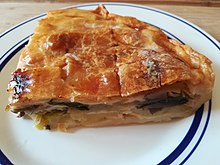Cholera (dish)
Cholera , pronounced locally in Goms Chouera , is a vegetable cake with leek , potatoes , cheese and apples that is prepared in the Swiss Valais . In the French-speaking Lower Valais, the dish is called le choléra .
Ingredients and preparation
Cholera is prepared differently depending on the region and personal preferences. Most recipes contain the following ingredients: shortcrust pastry or puff pastry and the filling made from leek, potatoes, cheese and apples. Onions and other vegetables, pears, bacon and raw ham are also represented in the various variants .
The dough is rolled out about 2 mm thick and placed in a baking pan. The edge of the dough that protrudes over the baking pan is placed over the filling after the pan has been filled. Other recipes include a separate piece of rolled out dough that is used like a lid to seal the filled baking pan airtight. Depending on the recipe, the baking time takes around 40–60 minutes at approx. 200 ° C.
Origin of the word
There is no reliable information about the origin of the word “cholera”.
An explanation - probably folk etymology - is that during the cholera epidemic around 1830, the Valais no longer left the house because of the risk of infection and prepared a meal whose ingredients were usually in the pantry and in their own garden at that time.
More likely, however, is a relationship with “ coal ”, in Valais German Chola or Cholu. The word explanation that the pan with the cholera was "put in the coal" for baking, however, encounters difficulties from a linguistic point of view, because the Swiss German denominative suffix -ere , which emerged from early High German -arja - apart from the feminine personal names - primarily for Designation of places where something occurs frequently. In fact, in Valais , Cholära is also a term for the “open anteroom in the bakery, where the coals were collected in a pit in front of the oven door”. In the case of cholera, as a name for a dish baked with charcoal, one should therefore think of a secondary transference to the food.
Individual evidence
- ↑ a b MySwitzerland.com standard recipe from Betty Bossi , accessed on March 27, 2013.
- ↑ Goms Cholera
- ↑ Heinrich Gubler: The liquid and nasal suffixes in the Swiss German noun formation. Diss. Univ. Basel. Wagner, Freiburg i. Br. 1920, p. 85 ff .; see. also Walter Henzen : German word formation. 3rd, revised and supplemented edition. Niemeyer, Tübingen 1965 (collection of short grammars of Germanic dialects B5), p. 163.
- ↑ Joh. Siegen: Bread in the Lötschental. In: Schweizer Volkskunde 46 (1956), pp. 65–71, here p. 67; Rudolf Hotzenköcherle and Rudolf Brunner (editors): SDS Phonograms. Texts accompanying the sound recordings for the Linguistic Atlas of German-speaking Switzerland , Volume 2. Francke, Bern 1976, p. 9.
- ↑ Christoph Landolt : Cholera, in: Wortgeschichten from February 24, 2016, ed. from the editors of the Swiss Idiotikon .
